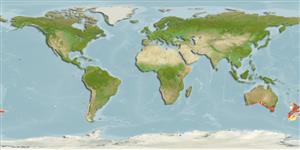Preferred temperature (ເອກະສານອ້າງອີງ
123201): 9.7 - 15.4, mean 13 °C (based on 84 cells).
Phylogenetic diversity index (ເອກະສານອ້າງອີງ
82804): PD
50 = 0.5156 [Uniqueness, from 0.5 = low to 2.0 = high].
Bayesian length-weight: a=0.00955 (0.00485 - 0.01879), b=3.13 (2.95 - 3.31), in cm total length, based on LWR estimates for this species & (Sub)family-body (Ref.
93245).
ຊັ້ນເຂດຮ້ອນ (ເອກະສານອ້າງອີງ
69278): 3.5 ±0.41 se; based on food items.
ຄວາມຢືດຢຸ່ນ (ເອກະສານອ້າງອີງ
120179): ຂະໜາດກາງ, ປະຊາກອນຕຳ່ສຸດທີ່ໃຊ້ເວລາສອງເທົ່າ 1.4 - 4.4 ປີ (K=0.36; tm=3-4; tmax=15).
Prior r = 0.29, 95% CL = 0.19 - 0.43, Based on 3 full stock assessments.
Fishing Vulnerability (Ref.
59153): Low to moderate vulnerability (33 of 100).
🛈
Climate Vulnerability (Ref.
125649): High to very high vulnerability (74 of 100).
🛈
Nutrients (Ref.
124155): Calcium = 21.4 [14.6, 40.2] mg/100g; Iron = 0.316 [0.197, 0.529] mg/100g; Protein = 17.6 [15.7, 19.5] %; Omega3 = 0.733 [0.427, 1.296] g/100g; Selenium = 22.4 [10.3, 42.4] μg/100g; VitaminA = 17.7 [6.7, 50.1] μg/100g; Zinc = 0.534 [0.400, 0.715] mg/100g (wet weight); based on
nutrient studies. 